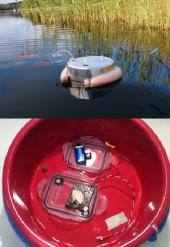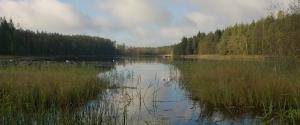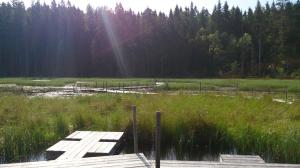Measurement overview

The study was carried out during one growing season from the end of May until the end of September in 2014, in two freshwater systems; Lake Erssjön and Lake Följesjön, situated outside of Vänersborg, Sweden. CO2-sensors were used to automatically measure CO2 from the water, continuously, during a desired period of time. The sensors measured CO2 in two ways; 1) by measuring pCO2, where the chamber along with the sensor was equilibrated with the water so that the CO2 concentration inside the chamber air corresponded to the pCO2 in the water, and 2) by measuring flux, using the CO2 values prior to the equilibrium in order to calculate the flux by an equation. One sensor each was attached inside a floating plastic chamber, which in turn was attached to a float and an anchor, and placed on the water surface. pCO2 was measured continuously during 3 weeks intervals, for a total of 6 measurement periods throughout the study. Flux was measured during 1 h periods (prior to equilibrium) every third week, resulting in 7 measurement periods. At the end of each measurement period, chambers were brought up from the lake and data was directly downloaded to a computer via a software program.
Complementary measurements
Weather variables such as: wind speed, air pressure, air temperature, radiation, were measured continuously throughout the study using a stationary weather station, situated at each lake. The water chemistry of the lake such as pH, phosphorus, dissolved organic carbon, among others, were measured once every third week at one spot in each lake. O2 and water temperature were measured continuously for 3 weeks in Lake Erssjön, and once every third week in Lake Följesjön.
Lake Erssjön

Lake Erssjön is a small, shallow (mean depth of 1.3 m and maximum depth of 4.9 m) forest lake. The water is brown-water colored, containing humic substances, but also fairly rich in more easily accessible nutrients. Lake Erssjön is surrounded by boreonemoral (deciduous and evergreen trees), a clear-cut and arable field. There were 20 chambers in total for measuring CO2 was covering all sections of the lake. Here, chambers were randomly deployed with regards to depth, wind and sun exposure.
Lake Följesjön

Lake Följesjönis a small, shallow (mean depth of 0.5 m) forest lake, which is in the late successional stage in the transition to a wetland. Lake Följesjön also has the characteristics of a brown-water lake and is partly eutrophic, and has clusters of floating emergent plants. Lake Följesjön is located downstream of Lake Erssjön and completely surrounded by boreonemoral forest. Since the study focused on Lake Erssjön, there were a total of 8 chambers in one transect for measuring CO 2 in Lake Följesjön.
Responsible for this page:
Director of undergraduate studies Biology
Last updated:
05/21/15
